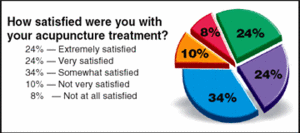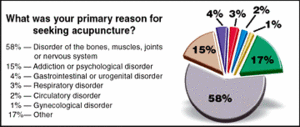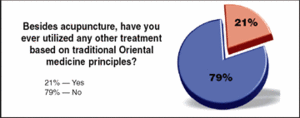Whether you accept it, avoid it or live somewhere in between, insurance coverage has become a defining issue for our profession. Patients increasingly expect to use their benefits, practitioners want to be compensated fairly for their time and expertise, and the system itself remains – at best – fragmented. The encouraging news is that coverage has expanded in meaningful ways. The challenging news is that reimbursement, across the board, remains inadequate.
Survey: Nearly 1 in 10 U.S. Adults Has Tried Acupuncture
The National Certification Commission for Acupuncture and Oriental Medicine (NCCAOM) has released the results of a national survey concerning the use of acupuncture in the United States. The survey, part of a public awareness campaign designed to avail Americans of the benefits of Asian healing, found that nearly one out of every ten adults in the U.S. has tried acupuncture. Adjusting these figures for the total number of American adults, the survey results indicate that approximately 20 million Americans over the age of 18 have tried acupuncture at some time in their life.
"This survey shows that acupuncture and Oriental medicine are clearly playing a role in the American health care system, either as freestanding modalities or complements to Western practice," observed Christina S. Herlihy, PhD, NCCAOM's chief executive officer. "At the same time, it indicates that there is a need for continued research and public education so more people can access and benefit from this important system of medicine."
The survey was conducted online by the internationally-known research firm Harris Interactive, and included 2,717 Americans age 18 or older. The survey was weighted for factors such as age; sex; race; education; region; and income to give a balanced representation of the U.S. population. The survey consisted of six multiple-choice questions:
- Have you ever received acupuncture?
- How satisfied were you with your acupuncture treatment?
- What was your primary reason for seeking acupuncture?
- What is your primary reason for not considering acupuncture?
- Which one of the following best describes you?
- Besides acupuncture, have you ever utilized any other treatment based on traditional Oriental medicine principles?





Results
- Nine percent of the respondents reported having received acupuncture. An additional 60% said that they would consider acupuncture as a treatment option.
- Almost half of those who had received acupuncture (48%) stated that they were "extremely satisfied" or "very satisfied" with treatment. Only 8% said they were not at all satisfied.
- Those who sought an acupuncturist for care did so for a variety of reasons, with disorders of the musculoskeletal or nervous system cited as the top reason. Nearly one-sixth of those who visited an acupuncturist sought treatment for an addiction or psychological disorder.
- Of the respondents who did not consider acupuncture, 59% said they were either satisfied with the health care they currently receive, or did not think there was enough scientific evidence that acupuncture works.
- An overwhelming majority of people who had not tried acupuncture said they would be willing to try it under certain conditions. More than half (51%) would try acupuncture if it was covered by insurance and their primary medical doctor recommended it. Another 20% would try acupuncture if their health insurance covered it. Only 15% said they would never consider acupuncture as a treatment option.
- One-fifth of the respondents reported having tried another form of traditional Oriental medicine besides acupuncture, such as herbs or Oriental bodywork.
The survey was conducted as part of NCCAOM's effort to increase the public's awareness of acupuncture and Oriental medicine as part of a larger system of healing that is used by millions of people worldwide to diagnose, treat and prevent disease, and improve well-being. The effort coincided with campaigns from other national acupuncture and Oriental medicine organizations in having October 24 declared as Acupuncture and Oriental Medicine Day.
"We want consumers to consider acupuncture and Oriental medicine as viable treatment options," commented NCCAOM Board Chair Daniel Jiao, Dipl.Ac. & CH. "In addition, we want consumers to seek out only the services of competent, professional providers."
The full results of the survey are available online at the official AOM Day website (www.aomday.org).
Editor's note: We would like to thank Troy Petenbrink of the National Certification Commission for Acupuncture and Oriental Medicine for providing the details of this survey to Acupuncture Today.



